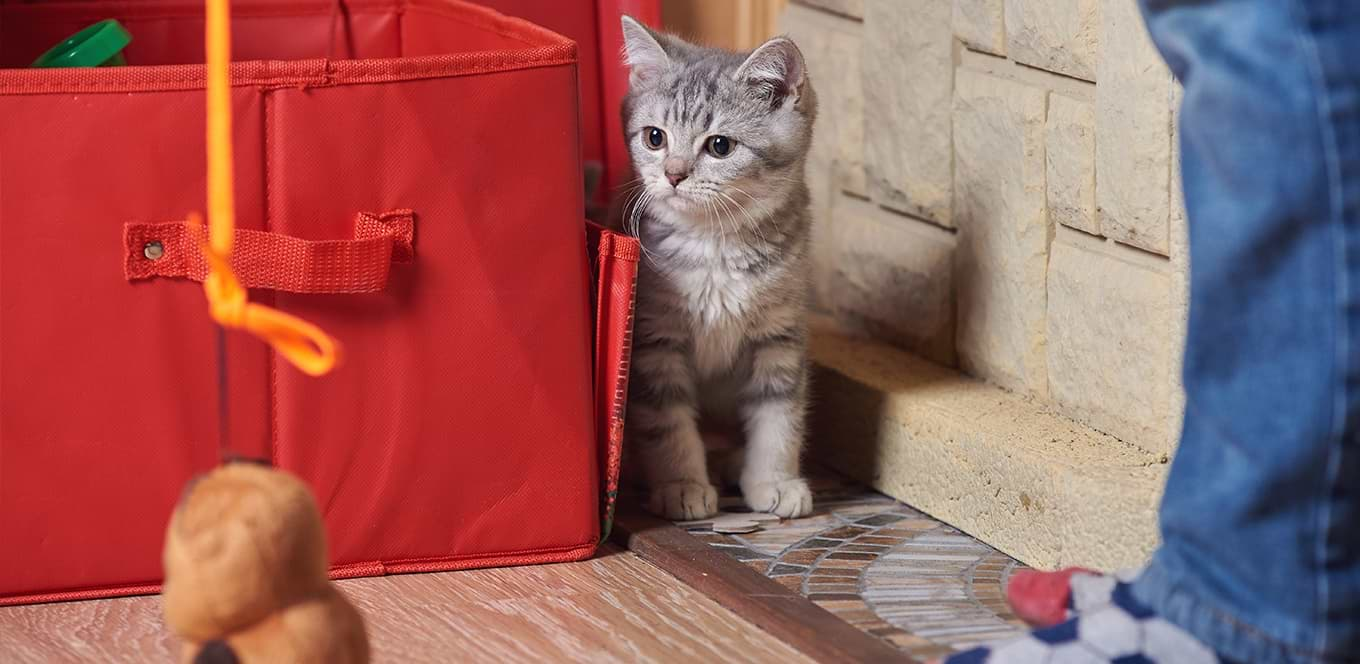

Kittens are curious, energetic fluffballs with boundless energy. A safe, enriching environment can cater to your kitten’s playful side, stimulate them physically and mentally, and benefit their health and development for the rest of their life.
Keeping your kitten indoors has significant benefits because it protects them from a large number of dangers. But without all the sights, sounds and smells of nature, a kitten needs other ways to stimulate their mind and body.
To build your kitten an enriching environment, provide them with safe places for hiding and resting, like window ledges, carriers or perches. Your kitten should feel protected in their safe spots and may prefer an enclosed resting area. While kittens spend a great deal of their time sleeping, their periods of wakefulness can and should be used to stimulate psychological and physical activity.
It’s important to create stimulating places for entertainment and play, as well. Cats can benefit from spaces at different vertical levels, like cat trees and perches. A variety of scratching posts can teach your kitten appropriate scratching while nurturing their natural instincts, and protect your furniture and carpet from their sharp claws.
Many cats also benefit from social activity with other cats, especially if they were introduced to other cats early in life. Providing your kitten with another kitten or young cat as a play buddy can help meet their need for near-constant play and motion. Keep in mind that cats put a premium on managing space, so it’s important that multiple-cat homes offer a variety of places to hide, sleep and observe, using both the horizontal and vertical dimensions.
An important component to enriching your kitten’s environment is socialization and play, especially if your kitten is the only animal in the household. A kitten’s natural predator-play behavior is usually easy to stimulate with interactive toys, such as wand toys or balls to pounce on or chase.
Playing kitten games with your pet helps them develop coordination and natural hunting skills. It also can help them learn boundaries and develop a bond with their new owner. Aim for 10 to 15 minutes of structured playtime two or three times a day. One way to prevent the “nighttime crazies” is to engage in active, vigorous play before feeding your kitten at bedtime. This helps wear out the kitten before bed and mimics the natural hunting-feeding-grooming-sleeping sequence in cats.
Engaging games to play with your kitten include:
An important component to enriching your kitten’s environment is socialization and play, especially if your kitten is the only animal in the household. A kitten’s natural predator-play behavior is usually easy to stimulate with interactive toys, such as wand toys or balls to pounce on or chase.
A greater challenge is providing enrichment opportunities for kittens when a person or another pet is not present to interact with them. Puzzle toys are one option to fight kitten boredom. These toys come in a variety of designs to entertain your kitten and reward her with a treat or food, such as IAMS™ ProActive Health™ Healthy Kitten with Chicken. This offers twofold benefits, providing play and proper nutrition for supporting a kitten’s energy and playtime.
Kittens and cats will spend a great deal of time watching the outside world through windows, especially if there’s a bird feeder or butterfly garden within view. Make sure to keep at least one window blind open — especially if it looks out on an area with frequent movement and activity. There are also a number of “cat TV” videos of squirrels, birds and other nature scenes available online to keep a cat entertained.
Providing your kitten with enrichment opportunities helps prevent stress and the development of abnormal behaviors. Growing from a kitten into a cat in an enriched environment with lots of physical and psychological exercise supports the overall well-being of your pet at all stages of her life.



Bringing a new kitten home can be exciting, especially if it is your first time. The day you have been looking forward to has finally arrived and you are ready to take on your responsibilities as a cat parent! However exciting it may be to embark on this journey, a caregiver should not forget to prepare their home for a kitten’s first day and night.
Start establishing a routine during your new kitten’s first week at home. For instance, start taking it to the vet, and introduce it to friends, family, and other pets. You should also be fully prepared for its first outings once it is fully vaccinated. Lastly, kitten-proofing your home is highly recommended. Bringing a new kitten home is no different than bringing a baby home. As a caregiver, you should put away all hazardous items in the house and create a safe space for your kitten.
For caregivers who are bringing a new kitten home, this article is the ideal read! Here’s what you need to know about introducing a new kitten to your home.
There are multiple things you need to do before getting a kitty into your house. For example, you must find a credible veterinarian in your vicinity. Especially because you have to take your newborn cat to the vet as soon as you adopt it. So, let’s explore other crucial steps to take before bringing a kitten home:
Kittens are tiny and delicate; hence, anything that can hurt or harm them should be put away. Make sure you have set up a sleeping space for your kitten, a food bowl, and a water bowl. Apart from that, place one or more litter boxes around your house depending on the size of your home. Make sure you cover any sharp edges of your furniture and don’t expose your kitten to any dangerous figures. Moreover, keep harmful plants and any toxic substances out of its reach.
For the first few nights, it is normal for new kittens to be anxious. It will take some time for a kitten to get used to its new home. It is also normal for your kitten to cry for the first few nights. You can make this experience better for it by setting up a cosy sleeping space. Once it gets comfortable in the new home, the kitty can even sleep for up to 20 hours a day.
It is not recommended to suddenly change your kitten’s food. Thus, find out what it was being fed by its previous caretaker. Stick to that meal plan for a few days and then gradually start changing your kitten’s diet. The best person to give you any advice on the right diet for kitties is a vet. Visit a veterinarian to receive a comprehensive feeding chart for your feline friend’s diet. For kittens between two to 12 months of age, IAMS Proactive Health Mother And Kitten dry food is ideal. It is loaded with protein, omega-3 fatty acids, vitamins, and minerals to support healthy brain and eye development. This kitten food also contains colostrum and DHA – two essential nutrients that provide immunity and protection against diseases.
Now, let’s take a deep dive into understanding the things that must be done once you have brought the kitty home:
The first step after bringing a kitten home is to introduce your new feline friend to its new family. Kittens can feel nervous around strangers; hence, familiarising them with their new family is imperative. Ensure that the atmosphere is calm and not too loud as they tend to get anxious. Your kitten should be handled gently if being picked up by anyone. Give your kitten the space it requires and let it explore the house by itself.
If you have any other pets or more cats, introducing a new kitten to the rest of them is important. After all, they have to coexist and should get along as soon as possible. The best way to make them accustomed to each other is through scent. Keep switching sleep blankets so your pets can get used to being around each other. You can also place one pet’s towel under the other’s food dish. By doing this, all your pets will slowly get used to the new kitten.
Maintaining your kitten’s health is a priority. One of the most important things to do as soon as you bring a new kitten home is to set up a vaccination plan with the vet. Hence, make sure you visit a veterinarian at the earliest. Stay consistent with all vaccination doses for your kitten’s overall well-being. Later on, start taking your pet for regular medical check-ups. The doctor will examine your kitten’s weight, teeth, ears, etc. to gauge its nutritional needs.
Once your kitten starts feeling a little comfortable in your house, it will start exploring the space. If you see your kitten roaming around, it is great news. This means that it has started trusting the people and environment. However, make sure your kitty doesn’t get hurt while exploring its new home. You also don’t want to keep interrupting your pet to protect it from sharp edges. Hence, do not skip kitten-proofing your house. When your kitten gets up to move around, resist the urge to cuddle; let it explore and find the most comfortable spot for itself.
We all know that a new kitten requires some time and space to adjust to its new surroundings. However, once your new feline friend is all settled in, you can start playing basic games with it. For instance, play with a string. Cats love to play hide-and-seek or peek-a-boo. Start rewarding it with treats when it plays with you. It will soon start trusting you. And when your kitty rubs its body against you, licks your hand, or shows any form of affection, you will know that you have earned its trust.